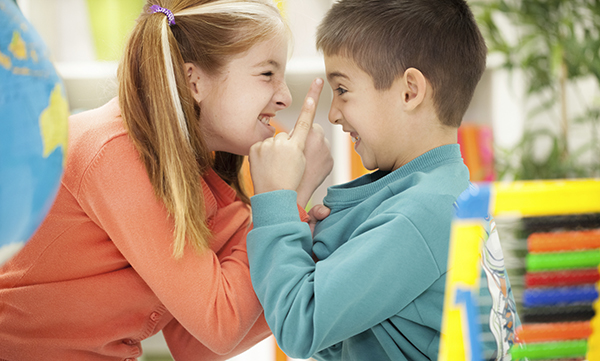The sink is plugged, the car has a flat tire, and Melinda needs help with a school project due tomorrow. On top of that, the kids haven’t stopped fighting and your headache is getting worse. Sound familiar?
Sibling conflict is one of the dynamics parents wish we could do without. Why can’t they just get along? Know that conflict between and among siblings helps children learn positive social skills and conflict negotiation. Moderate amounts of conflict play a potentially beneficial role in future relationships and social interactions when it is balanced by warmth and support. Helping children learn ways to deal more effectively with their rivalry ultimately teaches them social skills for a lifetime. Sibling rivalry is a natural part of family life; it does not mean that your children don’t like one another. What is more relevant for the long term is how we interact and resolve—or not resolve—discord.
Competition for your attention and approval is one of the main reasons sibs fight. Consider some helpful suggestions to get beyond the rivalry and enhance your children’s relationships with you and with each other.
- Avoid taking sides. Do not assume one child to be at fault (the older one, the boy, the one who ran to the other room, etc).
- Treat each child as an individual and avoid comparisons. Look for individual strengths, interests, and needs. Help children find ways shine and succeed. Acknowledge their efforts and their successes, even when very small.
- Don’t let kids make you think that everything always has to be “fair” and “equal” — sometimes, one kid needs more than the other.
- Empathy allows a child to feel seen and heard. Listen to both sides of the story, and model reflective listening. Acknowledge each child’s feelings without taking sides or trying to talk them out of what they feel. It is hard to hear our children express anger and jealousy toward one another, and it is normal for them to feel this way from time to time. Statements such as the following acknowledge a child’s feelings and express empathy: “I see how upset you are that she took apart your puppet show,” “It makes sense to me that you sometimes wish your sister were never born,” and “I know that sometimes it is really hard to share me with the baby.” Both children and adults, when they believe that they have been seen and heard, are more able to let go and move on with one another. They are also more able to understand their sibling’s perspective when they feel understood themselves.
- Engage them in ways to sort out the problems and review consequences for particular actions. When children are part of a process, they can exercise some control.
- Be proactive in giving your children quality time alone on a regular basis, time that is directed to their interests and needs. Being present, available, and interested in them is paramount.
- In actions and words, let your children know that love is not something that comes with limits. We don’t always like each other yet we still love each other, even when angry.
- Children, like adults, need their own possessions, their own space, and their own time alone. Do not always make them share, play together, or be included in social dates with each other’s friends.
- Post schedules to manage the issue of taking turns—i.e., who gets to comb the dog, have the special cup, etc.
- Recognize when children need time apart from each other and from family dynamics. Arrange separate play dates or activities for each kid occasionally. When one child is on a play date, you can spend one-on-one time with another.
- Children often fight in order to get your attention. Maybe you take a “time-out” yourself. When you leave, the incentive for their fighting is gone.
- Have fun as a family. Watching a movie, playing a game, doing some fun art or cooking projects are ways for your children to enjoy being together and have fun. Fun family activities help reduce conflict.
- Role playing is a fun way to help children see what it is like to be the other, including being the Mom and Dad!
- Intervene when necessary: With younger children, we have to intervene more often than we do with older children. Stop physical and aggressive behaviors. Enforce the “no-hitting” rule. Many times, we can offer possible solutions that will help teach children conflict resolution. Some examples: trading toys, taking turns, negotiating and compromising solutions that are acceptable to both children. These are skills children need to learn, and they are our job to teach. The various ways that you role model ways to handle differences and conflicts are teaching your children how to handle these kinds of situations as they mature.
Bonnie Romanow, BA, is a parent educator and early childhood mental health consultant at Parents Place.

